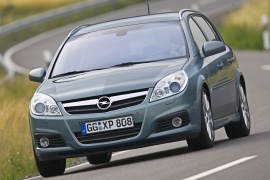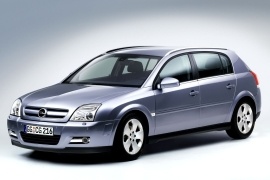OPEL Signum Models/Series Timeline, Specifications & Photos
First production year: 2003
Engines: Gasoline, Diesel
Body style: Hatchback
After the dismissal of the Opel Omega in 2003, the German car-maker needed a new offer in the executive market and it came with the Signum, which was refreshed in 2005 along with the Vectra range.
The Opel Signum was the big flop on the German car-maker range. It was based on the long-wheelbase platform of the Vectra Station-wagon and, while the front was identical with its lesser brother, the rear was different but resembled the Opel/Vauxhall Astra, which was a compact hatchback. The 2005 refresh brought a new exterior look, new interior features, and a new engine.
From the outside, the most striking difference was on the headlights. The new parts were bigger and extended toward the A-pillar. The hood and the front fenders were changed. A wide chromed bar with the large Opel badge was the dominant feature of the grille.
Inside, the Signum retained its four-seats architecture with two separate places for the rear occupants. Due to its long roofline and 2.83m (111”) wheelbase, it offered plenty of legroom and headroom. There was a new, three-spoke steering wheel, new wood grains, aluminum, or carbon-look trims.
The engine lineup was completed with five gasoline engines (1.6 - 2.8 liter, 100 - 230 hp) and four CDTI common-rail types of diesel (1.9 - 3.0 liter, 100 - 184 hp). The top model was fitted with a turbocharged gasoline V6 unit. Apart from the base, 100 hp engine, which was fitted with a 5-speed manual, all the others were fitted as standard with a 6-speed manual. The 2.8 V6 Turbo, the 150 hp 1.9 CDTI, and the 3.0 V6 CDTI were available with a 6-speed automatic.
The German automaker made a vehicle to compete against premium automakers, so after discontinuing the Omega, it tried its luck with the Signum.
Based on the same platform as the Vectra lineup, the Signum was a different approach on the market. While it shared most of its components with its smaller sibling, the extended wheelbase and the large cabin in the back were supposed to bring some customers back after migrating to BMW or Mercedes-Benz. But the strategy didn't work.
With a front fascia that resembled the mundane Vectra, a car built mostly for lower-middle-class customers, the Signum couldn't impress too much. Its headlights swept back over the hood that flanked a grille with a horizontal slat, and the lower air intake in the bumper was far from considered premium. In addition, the car's hatchback shape with thick C-pillars and tilted-forward tailgate was nothing to write home about it.
Inside, Opel didn't struggle too much to create an exquisite cabin. Its slightly curved dash panel and the arched line of the instrument cluster didn't match the flat vertical center stack. It is true that everything was easy to reach, but the design was far from being considered luxurious. Moreover, the materials used were similar to those from the mundane Vectra, although customers could choose leather seats. But the Signum had an ace up its sleeves, and that was the room for the rear-seated passengers. Thanks to the extended wheelbase and the tall roof, the car provided more than enough room for two people. Still, that wasn't enough to convince customers.
With its drivetrain carried over from the Vectra and the front-wheel-drive platform, the Signum was not very convincing.

